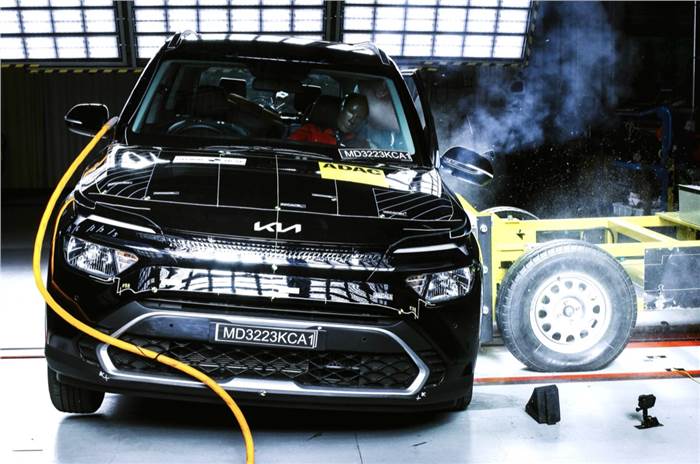Kia Carens Safety Evaluation:
Kia Carens underwent comprehensive crash testing, resulting in distinct safety ratings across different assessments. Initially, it received a 0-star rating for adult occupant protection (AOP) due to poor neck protection for the driver, marginal chest protection, and limited knee protection for both driver and passenger. However, subsequent improvements led to a notable enhancement in its safety profile, achieving a 3-star rating for adult occupant protection. This improvement was attributed to enhanced restraint systems, particularly addressing neck protection, chest impact, and knee safety. Notably, Kia Carens excelled in child occupant protection (COP), securing a 5-star rating. Its advanced safety features, including six airbags, Electronic Stability Control (ESC), and ISOFIX anchors, contributed to its commendable performance in safeguarding child occupants.

Honda Amaze Crash Test Analysis:
The Honda Amaze faced rigorous scrutiny in crash tests, revealing mixed safety outcomes. It obtained a 2-star rating for adult occupant protection and a concerning 0-star rating for child occupant protection. The adult occupant protection rating highlighted deficiencies such as the lack of optional side head protection, absence of Electronic Stability Control (ESC) as standard, and limited seat belt reminders. These factors contributed to suboptimal protection levels for the driver and passengers in various impact scenarios. In terms of child occupant protection, the Amaze showcased vulnerabilities, particularly in head and neck safety for child occupants during frontal impacts. The absence of three-point seat belts for all seating positions and limited child restraint system (CRS) provisions further impacted its child safety rating. Although Honda has made recent safety feature updates, including seat belt reminders for all seats, the tested model’s safety rating underscores areas for improvement in future iterations.

Mahindra Bolero Neo Safety Performance:
The Mahindra Bolero Neo’s crash test results highlighted significant safety concerns, garnering a 1-star rating for both adult and child occupant protection. The vehicle exhibited structural instability and inadequate protection in critical areas, such as the chest and feet for the driver, during crash simulations. Key factors contributing to its low safety rating included the absence of curtain airbags, limited seat belt reminders for all passengers, and reliance on an older platform that lacked modern safety enhancements. Additionally, the presence of side-facing third-row seats raised safety concerns, as such seating configurations are deemed less safe according to global safety standards. The Bolero Neo’s safety performance underscores the importance of integrating advanced safety features and structural reinforcements to meet evolving safety expectations.

Conclusion:
The detailed crash test analyses of Kia Carens, Honda Amaze, and Mahindra Bolero Neo provide critical insights into their safety performances. While Kia Carens demonstrated significant improvements, particularly in adult occupant protection and child occupant protection, Honda Amaze and Mahindra Bolero Neo faced challenges in meeting stringent safety standards. Manufacturers must prioritize the integration of advanced safety technologies, structural enhancements, and safety features across their vehicle models to ensure comprehensive occupant protection and alignment with global safety benchmarks.
